The blogger visited Rome in December 2005 and explored various landmarks including the Colosseum, Pantheon, Vatican Museums, Sistine Chapel, Spanish Steps, and Piazza Navona. They also enjoyed shopping and local cuisine, and took advantage of public transportation, such as the metro, to get around the city.


1. Overall Rating (0–10) — 7.5
This photograph captures the grandeur of a historic building with a striking sense of verticality and architectural detail, set against a bold, cloudless sky. The low-angle perspective emphasizes the monumentality of the structure, while the vibrant green sign adds a modern contrast to the classical façade. The image succeeds in blending historical elegance with contemporary identity, though the composition’s strong diagonal edge slightly disrupts the visual harmony.
2. Composition (0–10) — 7.0
The low-angle shot creates a dynamic sense of scale, with the building’s dome rising diagonally into the frame. The placement of the "EXCELSIOR" sign adds a strong horizontal element that balances the upward thrust of the dome. However, the right edge of the frame cuts off part of the structure, creating a slight visual imbalance.
3. Lighting (0–10) — 8.0
The bright, direct sunlight enhances the texture and depth of the ornate stonework, casting crisp shadows that accentuate the building’s intricate details. The clear blue sky provides a clean, high-contrast backdrop that makes the structure pop.
4. Color & Tone (0–10) — 7.5
The warm golden tones of the building contrast beautifully with the deep blue sky and the vibrant green of the sign. The color palette is harmonious and vivid, creating a visually striking image with a strong sense of place and time.
5. Creativity (0–10) — 7.0
The juxtaposition of the ornate, classical architecture with the bold, modern signage introduces a compelling narrative about the blending of history and contemporary identity. The low-angle perspective adds a cinematic quality, elevating the image beyond a simple architectural portrait.
6. Technical Quality (0–10) — 8.0
The image is sharp and well-focused, with excellent clarity in both the architectural details and the signage. The exposure is well-balanced, capturing detail in both the highlights and shadows without overexposure.
7. Emotional Impact (0–10) — 7.5
The photograph evokes a sense of awe and nostalgia, inviting the viewer to appreciate both the craftsmanship of the past and the enduring presence of the building in the present. The bright, clear day and the commanding view lend the image an uplifting, celebratory mood.
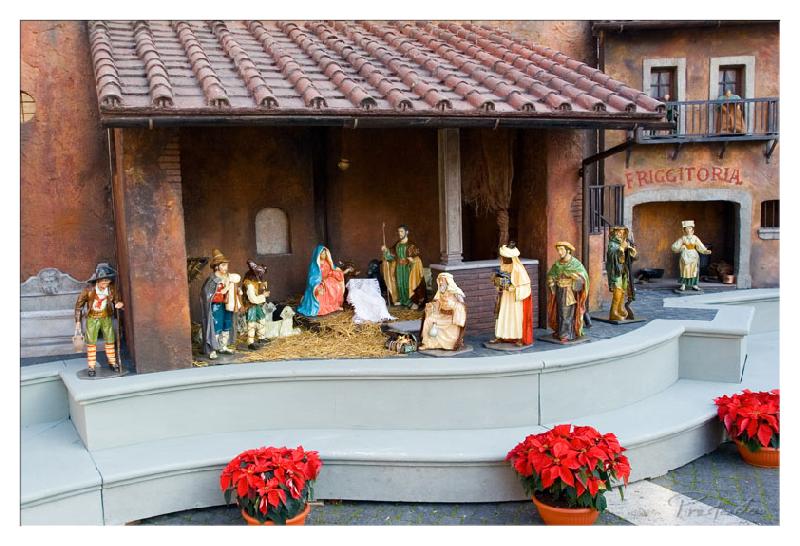

1. Overall Rating (0–10) — 7.0
This photograph captures a vibrant and reverent nativity scene, blending tradition with a sense of place through its detailed figurines and architectural backdrop. The warm tones and carefully arranged figures convey a narrative depth, while the potted poinsettias in the foreground add a festive touch that grounds the scene in a contemporary setting. Though the composition is slightly cluttered by the surrounding elements, the image succeeds in evoking the spirit of the season with a quiet, contemplative mood.
2. Composition (0–10) — 6.5
The scene is framed to include both the nativity figures and the surrounding architecture, creating a layered narrative. However, the placement of the poinsettias in the foreground slightly disrupts the visual flow, drawing attention away from the central figures.
3. Lighting (0–10) — 7.0
Natural daylight illuminates the scene evenly, highlighting the textures of the figurines and the terracotta roof. The soft shadows enhance depth without obscuring key details, lending a calm and authentic atmosphere.
4. Color & Tone (0–10) — 7.5
The warm earth tones of the building and roof harmonize with the vibrant red of the poinsettias, creating a balanced and festive palette. The subtle color contrast between the figures and the background adds visual interest without overwhelming the scene.
5. Creativity (0–10) — 7.0
The integration of the nativity display within a real-world setting—complete with a shop sign reading “FRIGGITORIA”—adds an unusual and engaging layer of cultural context. This juxtaposition of sacred and secular life lends a unique storytelling quality.
6. Technical Quality (0–10) — 8.0
The image is sharp and well-focused, with clear details in both the figurines and the architectural elements. The exposure is balanced, and the depth of field effectively keeps the central figures in focus while softly blurring the background.
7. Emotional Impact (0–10) — 7.5
The photograph evokes a sense of tradition, faith, and community, inviting viewers to reflect on the meaning of the nativity within a living, breathing environment. The warmth and care in the display create a gentle emotional resonance.
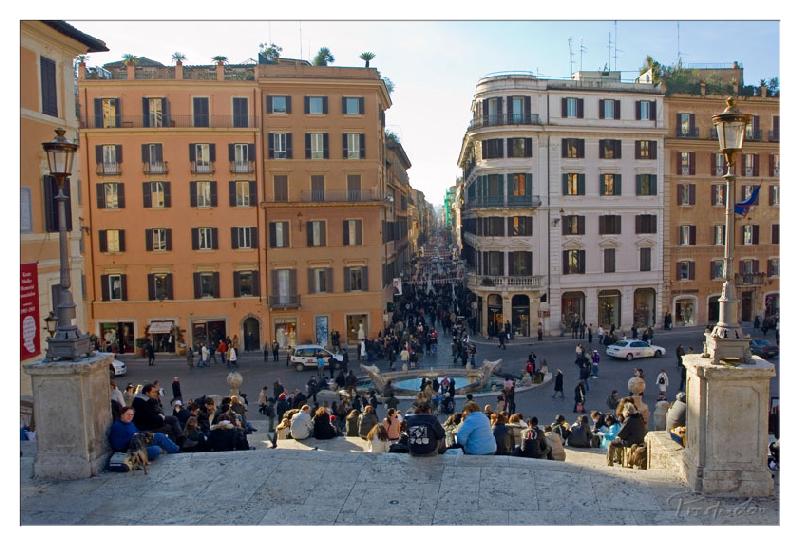

1. Overall Rating (0–10) — 7.5
This photograph captures the vibrant energy of a bustling European piazza, where the grandeur of historic architecture meets the rhythm of everyday life. The composition draws the eye down the wide staircase and into the heart of the city, creating a sense of depth and immersion. While the scene is rich in detail and atmosphere, the slightly overexposed sky and cluttered foreground detract from its visual harmony, preventing it from achieving a more refined aesthetic.
2. Composition (0–10) — 8.0
The use of the staircase as a leading line effectively guides the viewer’s gaze into the frame, creating a strong sense of perspective. The balanced framing, with symmetrical lampposts on either side, adds structure, though the density of people on the steps slightly disrupts the visual flow.
3. Lighting (0–10) — 7.0
The late afternoon sunlight bathes the buildings in a warm golden hue, enhancing the texture and color of the facades. However, the sky is overexposed, losing detail in the clouds and creating a slight imbalance in tonal distribution.
4. Color & Tone (0–10) — 7.5
The warm terracotta tones of the buildings contrast beautifully with the cool shadows and the pale stone of the steps. The palette is rich and inviting, though the slightly washed-out sky tempers the overall vibrancy.
5. Creativity (0–10) — 7.0
The image successfully captures the essence of a lively urban space, blending architectural grandeur with human activity. While not overtly experimental, it tells a compelling story of place and movement.
6. Technical Quality (0–10) — 8.0
The focus is sharp throughout, capturing fine details in the buildings and people. The image is well-exposed in the midtones, though the overexposed sky indicates a slight limitation in dynamic range.
7. Emotional Impact (0–10) — 7.5
The photograph evokes a sense of warmth, community, and timeless urban life. The presence of people relaxing and moving through the space creates a relatable, human-centered atmosphere that resonates with viewers.
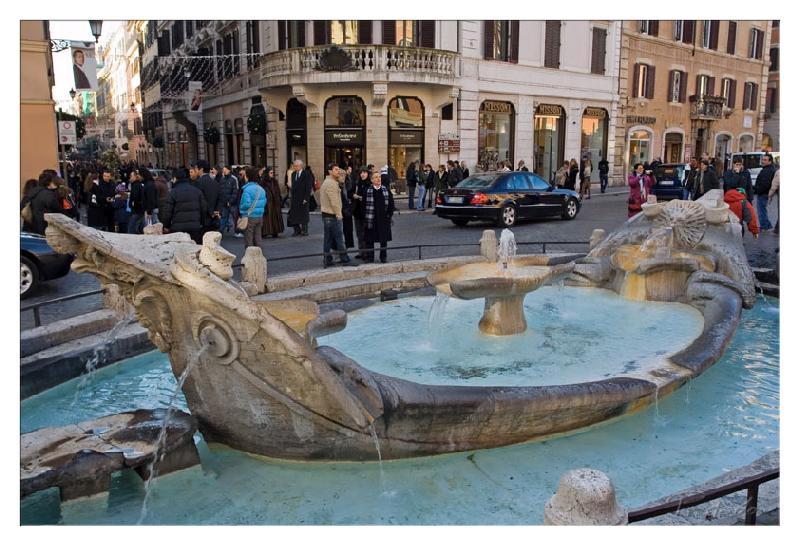

1. Overall Rating (0–10) — 6.0
This photograph captures the bustling energy of a historic European square, centered on a striking boat-shaped fountain that serves as a visual anchor. The scene is rich with movement and texture, from the flowing water to the crowd navigating the narrow space. While the image conveys a sense of place and daily life, its composition feels slightly cluttered and lacks a strong focal clarity, preventing it from achieving a more compelling visual narrative.
2. Composition (0–10) — 5.5
The fountain is well-framed but slightly off-center, and the surrounding crowd and vehicles create visual noise. A tighter crop would enhance focus on the fountain's intricate details and reduce distractions.
3. Lighting (0–10) — 6.0
Natural daylight provides even illumination, with soft shadows suggesting midday or early afternoon. The light enhances the texture of the stone and the reflective quality of the water, though it lacks dramatic contrast or mood.
4. Color & Tone (0–10) — 6.5
The palette is dominated by earthy stone tones and cool water blues, with subtle pops of color from clothing in the background. The color balance is natural but restrained, giving the image a subdued, documentary feel.
5. Creativity (0–10) — 6.0
The choice to capture a moment of urban life around a historic fountain is grounded in observation rather than bold artistic interpretation. The image tells a story of place and function but doesn’t push beyond the familiar.
6. Technical Quality (0–10) — 7.0
The image is sharp and well-exposed, with clear detail in the fountain’s carvings and the water’s motion. The focus is consistent, though some areas in the background appear slightly soft.
7. Emotional Impact (0–10) — 5.5
The photograph evokes a sense of everyday life in a vibrant city, but the emotional resonance is muted. The viewer is an observer rather than a participant, and the lack of a central human subject or narrative moment keeps the connection to the scene from deepening.
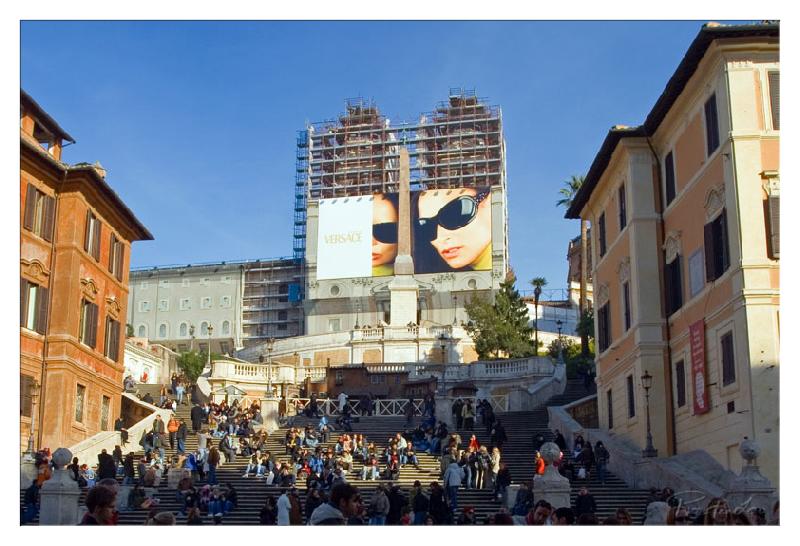

1. Overall Rating (0–10) — 7.0
This photograph captures the vibrant energy of the Spanish Steps in Rome, where ancient architecture collides with modern commercialism. The towering Versace advertisement, wrapped around a scaffolded building, creates a striking visual juxtaposition against the classical stonework and blue sky. While the image effectively conveys the bustling atmosphere and cultural tension, its composition feels slightly overwhelmed by the sheer number of people and the dominant commercial element, which risks overshadowing the historic site’s intrinsic beauty.
2. Composition (0–10) — 6.5
The wide-angle perspective captures the full breadth of the steps and surrounding buildings, but the central placement of the Versace ad draws the eye away from the natural focal point—the staircase and its visitors. The diagonal lines of the stairs guide the eye upward, yet the frame feels crowded, with too much visual noise from the scaffolding and signage.
3. Lighting (0–10) — 8.0
Bright, natural daylight enhances the clarity and saturation of the scene, casting soft shadows that define the textures of the stone and buildings. The clear blue sky provides a strong backdrop that contrasts with the warm tones of the architecture, giving the image a crisp, sun-drenched quality.
4. Color & Tone (0–10) — 7.5
The palette balances warm terracotta and ochre tones of the buildings with the cool blue of the sky and the bold black, white, and gold of the Versace ad. The color contrast between the historic and modern elements adds visual interest, though the ad’s bright colors slightly dominate the natural harmony.
5. Creativity (0–10) — 7.0
The image thoughtfully juxtaposes Rome’s timeless beauty with contemporary consumer culture, creating a layered narrative about modernity’s encroachment on heritage. The inclusion of the ad as a central visual element is bold and conceptually rich, though the execution leans slightly toward documentary over artistic interpretation.
6. Technical Quality (0–10) — 8.5
The photograph is sharp and well-exposed, with clear detail across the frame. The dynamic range is well-managed, preserving detail in both the bright sky and shaded areas of the steps. The wide-angle lens is used effectively to capture the scene’s scale.
7. Emotional Impact (0–10) — 6.5
The image evokes a sense of urban vitality and cultural collision—both exciting and slightly jarring. While it captures the energy of a global tourist destination, the overwhelming presence of commercial branding tempers the emotional resonance, leaving the viewer with a more critical than nostalgic impression.
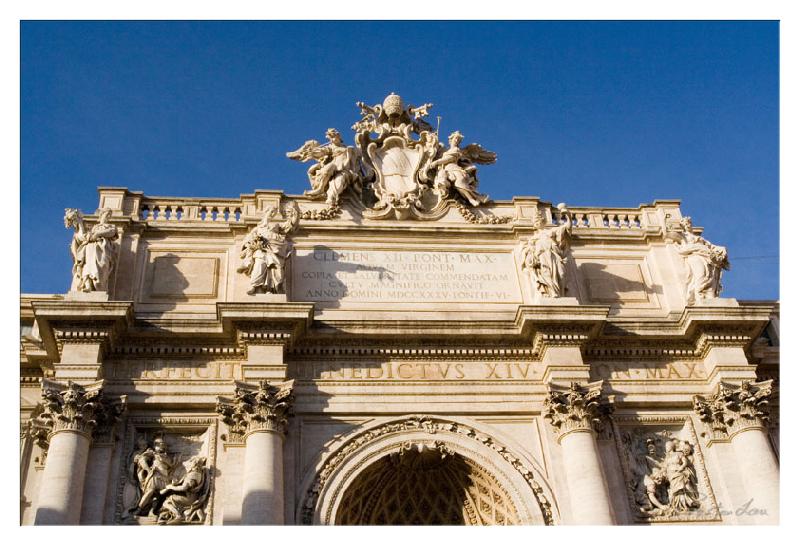

1. Overall Rating (0–10) — 8.0
This photograph captures the grandeur of the Trevi Fountain with striking clarity and a bold sense of scale, emphasizing its classical architecture against a vibrant blue sky. The low-angle perspective enhances the monumentality of the structure, while the crisp sunlight accentuates the intricate details of the stonework. Though the image is visually powerful, the tight framing slightly limits the full context of the fountain’s setting, preventing it from feeling completely immersive.
2. Composition (0–10) — 8.5
The low-angle view creates a dynamic upward perspective, drawing the eye toward the ornate sculptural centerpiece. The symmetry of the facade is well-balanced, with the central arch and inscriptions anchoring the composition, while the flanking columns and statues provide visual harmony. The inclusion of the sky as a clean backdrop enhances the architectural lines without distraction.
3. Lighting (0–10) — 9.0
The bright, direct sunlight enhances the texture and depth of the marble, casting strong shadows that define the relief sculptures and architectural details. The contrast between light and shadow adds dimension and drama, while the clear blue sky provides a rich, saturated backdrop that complements the warm tones of the stone.
4. Color & Tone (0–10) — 8.5
The palette is dominated by the warm beige of the marble and the deep, saturated blue of the sky, creating a striking and harmonious contrast. The tonal range is well-balanced, with rich highlights and deep shadows contributing to a sense of grandeur. The overall color temperature feels natural and evocative of a bright, sunny day in Rome.
5. Creativity (0–10) — 7.5
The image leverages a classic architectural subject with a strong compositional approach, emphasizing form and structure over narrative. While the photograph is technically sound and aesthetically pleasing, it leans more toward documentation than conceptual interpretation, offering a familiar view with a modern clarity.
6. Technical Quality (0–10) — 9.0
The image is sharp and detailed, with excellent focus on the intricate carvings and inscriptions. The exposure is well-managed, capturing both the bright highlights and the deeper shadows without loss of detail. The clarity and resolution enhance the viewer’s appreciation of the craftsmanship.
7. Emotional Impact (0–10) — 8.0
The photograph evokes a sense of awe and timelessness, capturing the majesty of one of Rome’s most iconic landmarks. The combination of scale, light, and composition creates a powerful emotional resonance, inviting the viewer to feel the historical weight and artistic grandeur of the scene.
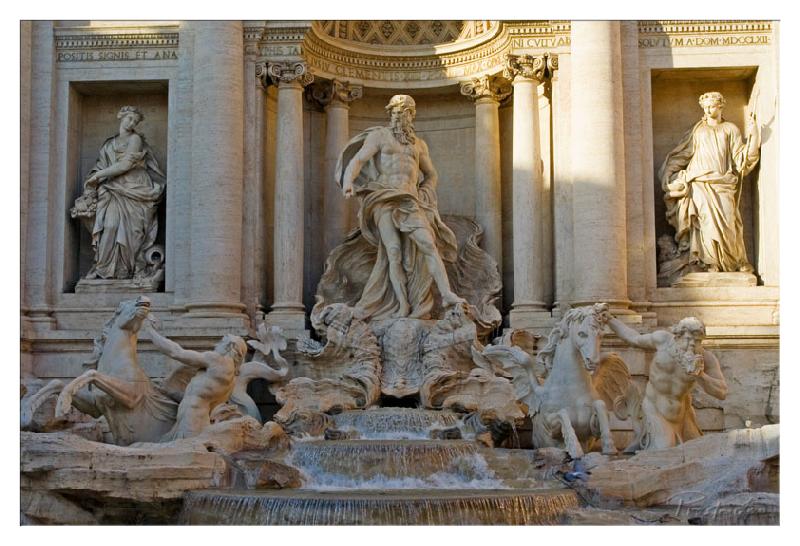

1. Overall Rating (0–10) — 8.0
This photograph captures the grandeur of the Trevi Fountain with a commanding sense of scale and historical weight. The interplay of light and shadow across the intricate marble sculptures enhances their three-dimensional presence, while the cascading water adds motion and life. Though the composition is dense and detailed, the image successfully conveys the monument’s dramatic narrative and architectural splendor, with only minor distractions from the overexposed highlights in the upper right.
2. Composition (0–10) — 8.0
The central figure of Neptune dominates the frame, creating a strong focal point, while the flanking statues and columns provide symmetry and balance. The low angle emphasizes the fountain’s verticality and scale, drawing the viewer into the scene. The inclusion of the water flow in the foreground adds depth and guides the eye toward the center.
3. Lighting (0–10) — 8.5
The warm, directional sunlight from the right enhances the textures of the marble, creating dramatic highlights and deep shadows that accentuate the sculptural forms. The golden hour glow lends a timeless, almost reverent quality to the scene, though the bright reflection on the upper right slightly overexposes the detail.
4. Color & Tone (0–10) — 7.5
The palette is rich with warm beige and golden tones, reflecting the sunlight on the stone, with subtle contrasts in shadow that deepen the visual depth. The water introduces cool, silvery highlights, creating a pleasing balance between warm and cool elements. While the overall tone is harmonious, the slightly washed-out highlights reduce tonal richness in parts of the frame.
5. Creativity (0–10) — 8.0
The image captures a classic subject with a sense of reverence and drama, emphasizing the fountain not just as a landmark but as a living work of art. The choice to frame it during the golden hour enhances its mythic quality, offering a fresh perspective on a well-known monument.
6. Technical Quality (0–10) — 8.0
The image is sharp and detailed, with clear focus across the central sculptures. The depth of field is well-managed, allowing both foreground and background elements to remain distinct. There is minimal noise, and the exposure is generally well-balanced, despite the minor overexposure in the upper right.
7. Emotional Impact (0–10) — 8.5
The photograph evokes awe and wonder, capturing the timeless beauty and emotional resonance of one of Rome’s most iconic landmarks. The interplay of light, motion, and grandeur invites contemplation, making the viewer feel the weight of history and the poetry of water in stone.
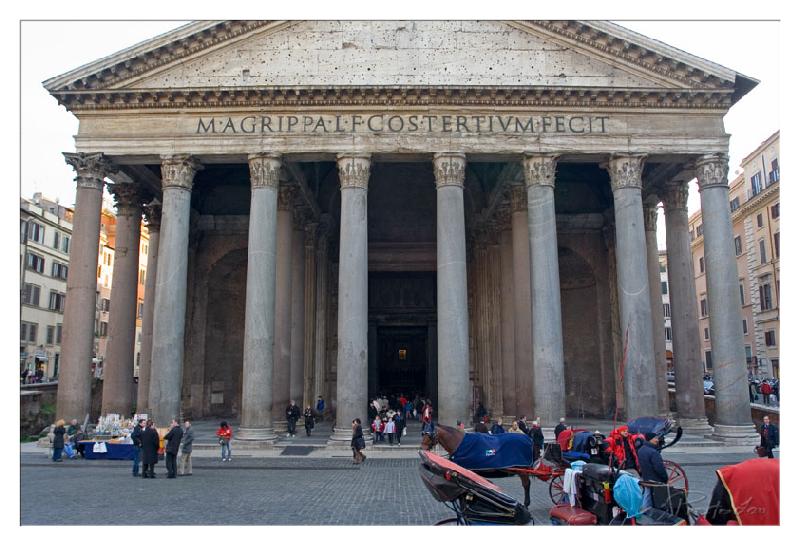

1. Overall Rating (0–10) — 7.0
This photograph captures the majestic presence of the Pantheon in Rome, blending ancient grandeur with the vibrancy of modern life. The composition effectively frames the temple’s monumental portico, while the scattered people and horse-drawn carriages add a sense of scale and narrative. While the image succeeds in conveying the site’s historical weight and public accessibility, the slightly flat lighting and overexposed sky diminish its atmospheric depth.
2. Composition (0–10) — 7.5
The symmetrical placement of the Pantheon’s columns anchors the image, creating a strong sense of balance and focus. The foreground elements—carriages and pedestrians—add layers and guide the eye toward the temple, though the low vantage point slightly compresses the space.
3. Lighting (0–10) — 6.0
The overcast sky produces soft, diffused light that minimizes harsh shadows and reveals texture in the stone. However, the lack of directional light and a washed-out sky reduce visual drama and contrast.
4. Color & Tone (0–10) — 6.5
The palette is dominated by neutral grays and muted earth tones, which reflect the aged stone and urban surroundings. While accurate, the colors lack richness and vibrancy, giving the image a slightly muted appearance.
5. Creativity (0–10) — 7.0
The photograph successfully juxtaposes ancient architecture with contemporary life, suggesting a living history. The inclusion of people and carriages adds a narrative layer, transforming a documentary shot into a story of continuity.
6. Technical Quality (0–10) — 8.0
The image is sharp and well-focused, with clear details in the columns and inscription. The exposure is generally balanced, though the sky is slightly overexposed, losing some detail in the clouds.
7. Emotional Impact (0–10) — 7.5
The image evokes a sense of awe and reverence for the Pantheon’s enduring legacy, while the presence of people and activity grounds it in the present. It invites contemplation on time, culture, and human connection to history.
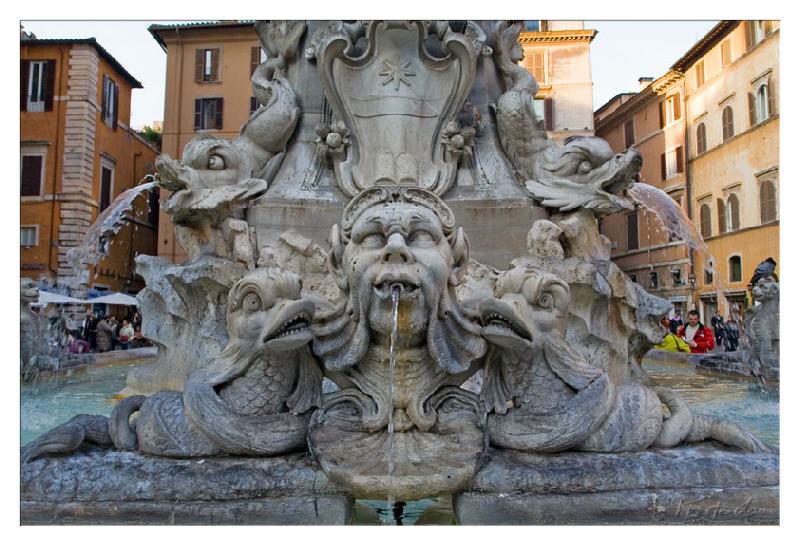

1. Overall Rating (0–10) — 7.0
This photograph captures the dramatic grandeur of the Fontana del Moro in Rome, where baroque excess meets urban life. The central grotesque face, water gushing from its mouth, commands attention, while the surrounding architectural warmth and ambient light lend a sense of time and place. The image succeeds in conveying the fountain’s theatricality, though the busy background slightly dilutes its focus, keeping it from feeling fully immersive.
2. Composition (0–10) — 6.5
The fountain is centered and fills the frame, creating a strong focal point. However, the inclusion of the background crowd and buildings introduces visual clutter, distracting from the sculptural detail.
3. Lighting (0–10) — 7.0
Natural, golden-hour light softly illuminates the stone, enhancing texture and depth. The warm tone complements the historic architecture, while the water’s motion adds a dynamic quality.
4. Color & Tone (0–10) — 6.5
The palette is harmonious, dominated by earthy terracotta and muted stone tones, with cool blue water providing contrast. The overall tone is balanced but lacks vibrancy, giving the image a slightly subdued feel.
5. Creativity (0–10) — 7.0
The framing emphasizes the fountain’s theatricality, capturing both its sculptural drama and its integration into daily life. The choice to include people in the background adds narrative context, suggesting the fountain as a living monument.
6. Technical Quality (0–10) — 8.0
Sharp focus on the central sculpture ensures clarity and detail. The exposure is well-balanced, with no significant loss of detail in highlights or shadows.
7. Emotional Impact (0–10) — 6.5
The image evokes a sense of awe and curiosity, inviting the viewer to imagine the sound of water and the bustle of the piazza. While the emotional resonance is strong, it remains somewhat restrained by the image’s documentary tone.
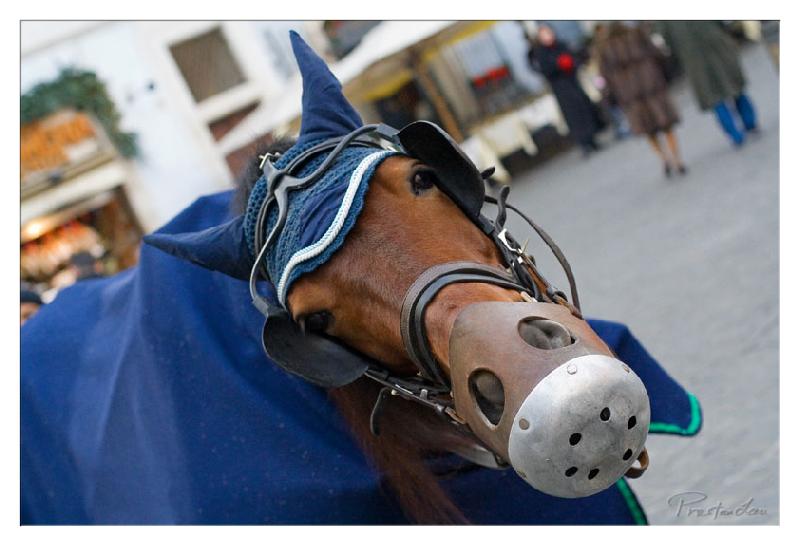

1. Overall Rating (0–10) — 7.0
This photograph captures a striking close-up of a horse adorned with a blue hood and a protective muzzle, set against the soft blur of a bustling street. The shallow depth of field draws immediate attention to the animal’s calm, observant gaze, creating a poignant contrast between the quiet dignity of the horse and the anonymous motion of the background. While the image succeeds in capturing a moment of stillness amidst urban chaos, it is slightly restrained by its muted tonal palette and the functional, rather than artistic, framing.
2. Composition (0–10) — 7.5
The horse’s head is placed slightly off-center, creating a dynamic diagonal that leads the eye from the muzzle toward the background. The use of shallow depth of field effectively isolates the subject, though the composition could benefit from tighter framing to emphasize the horse’s presence.
3. Lighting (0–10) — 6.5
Natural, diffused daylight illuminates the scene evenly, preserving detail on the horse’s face without harsh shadows. The lighting is functional and clear, but lacks the warmth or drama that might elevate the mood.
4. Color & Tone (0–10) — 6.0
The dominant blue of the hood creates a strong visual anchor, but the overall palette remains subdued, with muted browns and grays that slightly dampen the image’s emotional resonance.
5. Creativity (0–10) — 7.0
The juxtaposition of a formally attired horse in a modern urban setting is inherently intriguing, suggesting a narrative of tradition meeting contemporary life. The choice of subject and perspective adds a layer of storytelling beyond mere documentation.
6. Technical Quality (0–10) — 8.0
Sharp focus on the horse’s face and muzzle ensures clarity, while the background blur is smoothly rendered. The image is technically sound, with good control over depth and exposure.
7. Emotional Impact (0–10) — 6.5
The horse’s calm expression evokes a sense of quiet endurance, inviting reflection on the unseen roles animals play in public life. The emotional connection is present but understated, leaving room for the viewer to project their own interpretation.
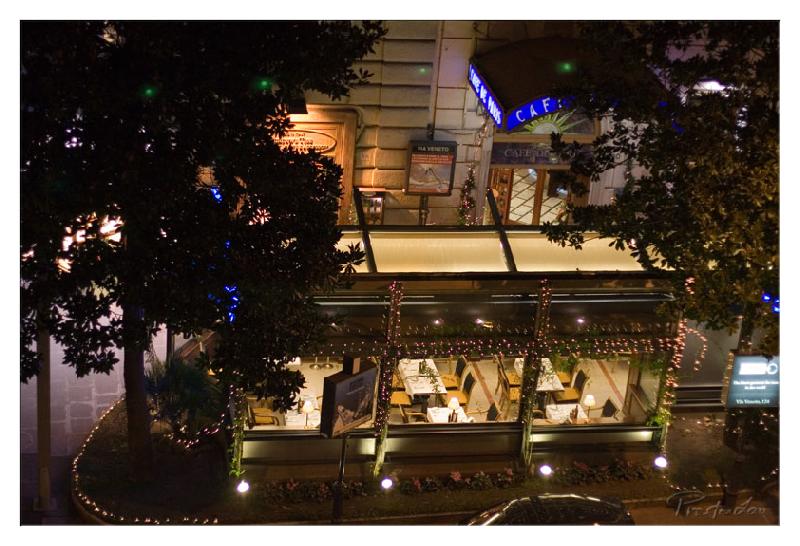

1. Overall Rating (0–10) — 7.0
This nighttime photograph captures the intimate glow of a café nestled within an urban setting, where warm interior lights contrast with the cool darkness of the surrounding city. The composition draws the eye into the inviting space, framed by leafy trees and twinkling string lights that evoke a sense of quiet charm. While the image successfully conveys atmosphere, its overall impact is slightly diminished by a lack of dynamic lighting and a somewhat flat perspective.
2. Composition (0–10) — 6.5
The elevated viewpoint provides a comprehensive view of the café, but the framing feels slightly cluttered, with the trees on either side creating a visual barrier. The central placement of the café grounds the image, though tighter cropping could enhance focus and intimacy.
3. Lighting (0–10) — 7.5
The interplay between the warm interior lighting and the cool ambient night tones creates a pleasing contrast. The string lights add a decorative touch, while the soft glow from the windows enhances the scene’s inviting mood, though some areas remain underexposed.
4. Color & Tone (0–10) — 6.5
The palette leans heavily on warm yellows and oranges from the interior, set against cool blues and blacks of the night. While harmonious, the color temperature could be more balanced to avoid an overcast, muddy appearance in the darker areas.
5. Creativity (0–10) — 7.0
The photograph captures a moment of urban stillness with a narrative quality, suggesting a quiet evening in a city alive with subtle energy. The use of festive lighting adds a touch of whimsy, making the scene feel both familiar and slightly magical.
6. Technical Quality (0–10) — 7.0
The image is sharp and well-exposed in the key areas, with clear details in the café’s interior and signage. However, some noise is visible in the darker regions, and the focus is slightly soft, reducing overall clarity.
7. Emotional Impact (0–10) — 7.5
There is a quiet, contemplative mood that invites the viewer to imagine themselves sitting at one of the tables, enjoying a warm drink on a cool evening. The combination of light, texture, and atmosphere evokes a sense of comfort and peaceful solitude.
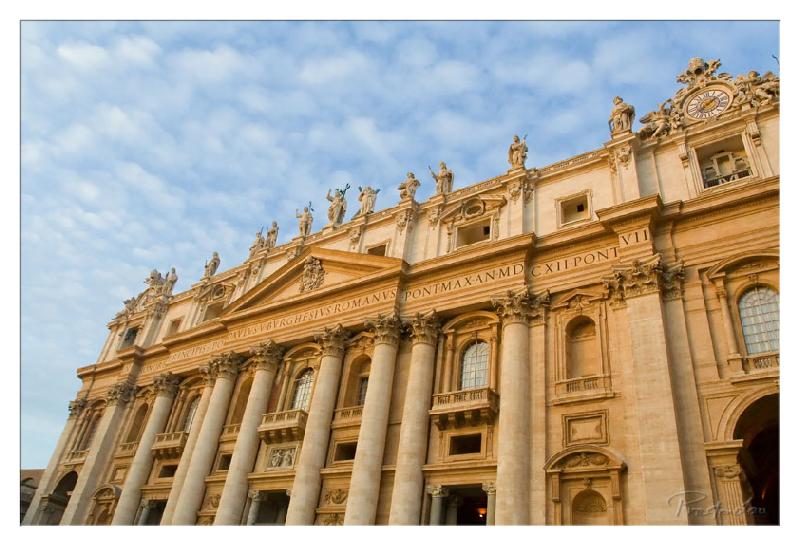

1. Overall Rating (0–10) — 8.0
This photograph captures the grandeur of St. Peter's Basilica with a sense of awe and reverence, emphasizing its monumental scale and intricate architectural detail. The low-angle perspective enhances the building’s verticality, while the soft, scattered clouds add a celestial touch that complements the sacred nature of the subject. Though the image is technically strong, a more dynamic sky or a sharper contrast in lighting could elevate its emotional resonance.
2. Composition (0–10) — 8.5
The low-angle shot effectively emphasizes the imposing height and symmetry of the basilica, drawing the eye upward along the columns and into the ornate pediment. The diagonal lines of the facade create a sense of movement, while the balanced placement of the structure within the frame enhances its architectural harmony.
3. Lighting (0–10) — 7.5
The soft, diffused sunlight enhances the texture of the stone and casts gentle shadows that define the building’s intricate details. The lighting is even and flattering, though slightly muted, which prevents dramatic highlights but maintains a serene, contemplative mood.
4. Color & Tone (0–10) — 8.0
The warm, golden tones of the travertine stone are beautifully rendered, creating a harmonious palette that feels both historic and timeless. The blue of the sky provides a pleasing contrast, while the overall tone remains balanced and natural, enhancing the image’s sense of dignity.
5. Creativity (0–10) — 8.0
The choice of angle and timing demonstrates a thoughtful approach to capturing the basilica’s majesty. The inclusion of the sky and the subtle interplay of light and shadow elevate the image beyond mere documentation, suggesting a narrative of faith and human achievement.
6. Technical Quality (0–10) — 9.0
The image is sharp, well-focused, and free of distracting noise or artifacts. The detail in the stonework and inscriptions is clear, and the exposure is well-managed, preserving information in both highlights and shadows.
7. Emotional Impact (0–10) — 8.5
The photograph evokes a profound sense of reverence and wonder, capturing the spiritual and historical weight of the basilica. The viewer is invited to feel small in the presence of such enduring beauty, making the image emotionally powerful and memorable.


1. Overall Rating (0–10) — 8.0
This photograph captures the grandeur and spiritual solemnity of a monumental interior, where light and architecture converge to evoke awe. The sweeping vaulted ceiling, rich with gold-leafed ornamentation, draws the eye upward, while the polished marble floor reflects the warm glow, amplifying the sense of scale. Though the presence of visitors adds a human element, the composition remains restrained and reverent, balancing the opulence of the space with a quiet dignity. A slight overexposure in the ceiling highlights could be refined to preserve subtle textures.
2. Composition (0–10) — 8.5
The strong symmetrical alignment of the columns and arches creates a powerful sense of depth and order, leading the viewer’s gaze toward the distant apse. The low-angle perspective enhances the verticality of the space, while the placement of figures near the left foreground provides scale and grounding without disrupting the harmony.
3. Lighting (0–10) — 8.0
Warm, directional lighting from recessed fixtures accentuates the intricate details of the ceiling frescoes and gilded moldings, creating a luminous, almost sacred atmosphere. The interplay of light and shadow adds dimension and depth, though the glow on the ceiling edges slightly flattens the texture.
4. Color & Tone (0–10) — 8.5
The dominant warm gold and amber tones of the ceiling harmonize beautifully with the cooler, neutral marble of the columns and floor, creating a rich, balanced palette. The contrast between the luminous ceiling and the darkened foreground enhances visual drama, while the polished floor reflects the light, adding depth and cohesion.
5. Creativity (0–10) — 8.0
The image successfully transforms an architectural subject into a contemplative visual narrative, emphasizing the interplay of light, scale, and craftsmanship. The choice to include a few figures adds narrative context, subtly suggesting human reverence for the space without overwhelming its grandeur.
6. Technical Quality (0–10) — 8.5
Sharp focus across the frame ensures clarity in both the foreground and background, with well-managed exposure and minimal noise. The camera’s resolution captures the fine details of the ceiling’s stucco and frescoes, while the dynamic range handles the contrast between light and shadow effectively.
7. Emotional Impact (0–10) — 8.5
The photograph evokes a profound sense of reverence and wonder, capturing the quiet majesty of sacred architecture. The viewer is invited to feel the weight of history and the transcendence of art, making the image not just a record, but an emotional experience.
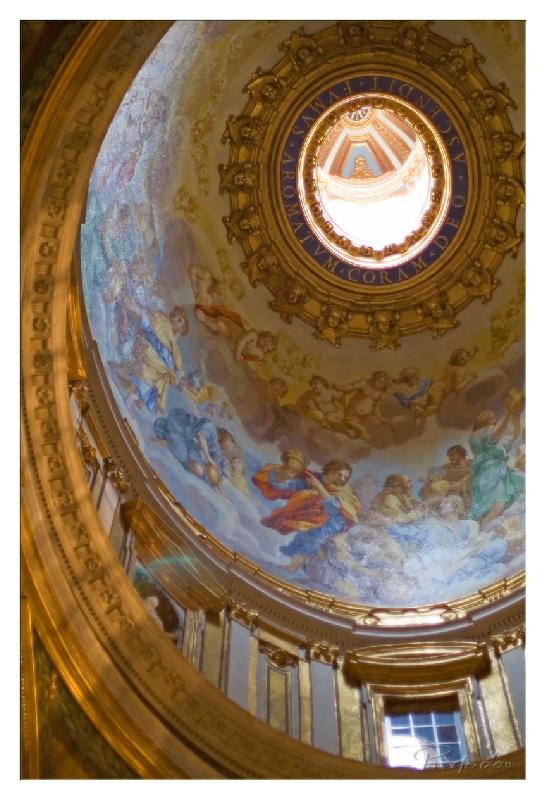

1. Overall Rating (0–10) — 8.0
This photograph captures the celestial grandeur of a Baroque dome with a reverent仰望, where light and artistry converge in a divine spectacle. The intricate frescoes and gilded ornamentation radiate opulence and spiritual aspiration, drawing the eye upward in awe. While the composition is visually rich, a slight overexposure in the central oculus and a minor lens flare detract from the image’s subtlety, preventing it from reaching its full emotional and technical potential.
2. Composition (0–10) — 8.5
The upward-looking perspective emphasizes the dome’s verticality and scale, with the circular frame guiding the viewer’s gaze toward the central oculus. The ornate border and painted figures create a layered, dynamic composition that balances symmetry and narrative depth.
3. Lighting (0–10) — 7.5
Natural light streaming through the oculus illuminates the center with a soft glow, enhancing the sense of divinity and drawing attention to the fresco’s focal point. The surrounding golden embellishments reflect the light, adding warmth, though the bright spot in the center slightly overwhelms the scene’s tonal harmony.
4. Color & Tone (0–10) — 8.0
The palette is rich and harmonious, with deep blues and golds creating a regal contrast that evokes the sacred atmosphere of the space. The subtle gradations in the fresco’s pigments lend depth, while the warm tones of the gilded architecture provide a sense of continuity and reverence.
5. Creativity (0–10) — 8.5
The choice to capture the dome from below with a wide-angle perspective is both bold and effective, transforming a static architectural feature into a dynamic visual narrative. The inclusion of the faint lens flare adds a touch of human imperfection, grounding the divine in a moment of real-world observation.
6. Technical Quality (0–10) — 7.5
The image is sharp and detailed, with excellent clarity in the frescoes and gilded elements. However, the overexposed oculus and slight chromatic aberration around the edges suggest limitations in dynamic range and lens performance.
7. Emotional Impact (0–10) — 8.5
The photograph evokes a profound sense of wonder and spiritual elevation, inviting the viewer to feel the awe of standing beneath such a monumental work of art. The interplay of light, color, and scale creates a deeply moving and contemplative experience.

1. Overall Rating (0–10) — 7.5
This photograph captures the solemn grandeur of a sacred space, where history, art, and human presence converge in quiet reverence. The composition draws the eye toward the richly detailed altarpiece, framed by marble columns and soft ambient light, evoking a sense of timelessness and spiritual depth. While the scene is visually compelling, the presence of modern visitors introduces a subtle tension between the sacred and the everyday, slightly diluting the image’s meditative power.
2. Composition (0–10) — 7.0
The central placement of the altarpiece creates a strong focal point, while the symmetry of the columns and the receding perspective of the nave guide the viewer’s gaze. The inclusion of figures in the foreground adds depth and narrative, though their placement slightly disrupts the visual balance.
3. Lighting (0–10) — 7.5
Warm, diffused lighting enhances the richness of the marble and the golden tones of the painting, while soft shadows lend depth and dimension. The lighting feels intentional and atmospheric, highlighting key elements without overexposure.
4. Color & Tone (0–10) — 8.0
The palette is harmonious, with warm terracotta marbles, deep golds, and soft shadows creating a cohesive and elegant visual tone. The contrast between the luminous painting and the muted surroundings adds depth and focus.
5. Creativity (0–10) — 7.0
The image successfully merges architectural grandeur with human presence, suggesting a narrative of continuity between past and present. While not overtly experimental, the framing and timing demonstrate thoughtful observation.
6. Technical Quality (0–10) — 8.0
Sharp focus across the image, balanced exposure, and clear detail in both the foreground and background indicate strong technical execution. The image is well-captured with minimal noise.
7. Emotional Impact (0–10) — 7.5
The photograph evokes a sense of awe and contemplation, inviting the viewer to reflect on the intersection of faith, art, and daily life. The quiet movement of people enhances the feeling of ongoing devotion, creating a subtle emotional resonance.

1. Overall Rating (0–10) — 7.0
This photograph captures a striking juxtaposition between ancient architecture and contemporary sculpture, evoking a dialogue between history and modernity. The large, fractured bronze sphere commands attention with its dramatic form and reflective surface, while the warm tones of the historic building provide a timeless backdrop. The image succeeds in framing a moment of cultural convergence, though the presence of tourists slightly detracts from the sculpture’s solemnity.
2. Composition (0–10) — 7.0
The sculpture dominates the foreground, creating a strong focal point, while the classical building in the background provides visual balance and context. The diagonal path and the arrangement of visitors lead the eye naturally into the frame, though the crowd slightly disrupts the composition’s harmony.
3. Lighting (0–10) — 8.0
The late afternoon sunlight bathes the scene in a warm golden glow, enhancing the texture and reflective quality of the bronze sphere. The soft, directional light creates subtle shadows and highlights that add depth and dimension to both the sculpture and the architecture.
4. Color & Tone (0–10) — 7.5
The warm orange and gold tones of the building harmonize beautifully with the metallic sheen of the sculpture, creating a cohesive palette. The blue sky provides a gentle contrast, while the green lawn adds a touch of natural vibrancy without overwhelming the scene.
5. Creativity (0–10) — 7.0
The image effectively captures a compelling narrative between past and present through the placement of the modern sculpture within a historic setting. The use of scale and perspective adds visual interest and invites contemplation on the relationship between art and its environment.
6. Technical Quality (0–10) — 8.0
The image is sharp and well-focused, with clear detail in both the sculpture and the architectural elements. The exposure is well-balanced, preserving detail in highlights and shadows alike, and the depth of field appropriately frames the scene.
7. Emotional Impact (0–10) — 7.0
The photograph evokes a sense of awe and contemplation, inviting the viewer to reflect on the enduring power of art and history. The scale of the sculpture and its placement in a public space suggest both monumentality and accessibility, creating a powerful emotional resonance.

1. Overall Rating (0–10) — 7.5
This photograph captures the opulent grandeur of a religious interior, where sacred art and ceremonial life converge in a breathtaking display of devotion and craftsmanship. The intricate fresco, vibrant colors, and ceremonial gathering create a sense of divine presence and historical continuity. While the image is rich in detail and symbolism, its overwhelming density slightly dilutes the viewer’s focus, preventing it from achieving a more refined visual harmony.
2. Composition (0–10) — 6.0
The image is framed to include both the monumental fresco and the ceremonial gathering below, but the sheer volume of figures and architectural elements creates a cluttered, almost chaotic arrangement. The central statue serves as a visual anchor, but the surrounding activity competes for attention, weakening the overall balance.
3. Lighting (0–10) — 6.5
The lighting appears to be a mix of natural and ambient sources, casting a warm glow across the scene that enhances the golden tones of the ceiling and drapery. However, some areas of the fresco and lower figures are underexposed, resulting in a loss of detail and depth.
4. Color & Tone (0–10) — 8.0
The palette is rich and varied, with deep reds, golds, and blues creating a regal and sacred atmosphere. The contrast between the illuminated figures in the fresco and the darker lower space adds visual drama, though some colors appear slightly oversaturated, giving the image a slightly artificial quality.
5. Creativity (0–10) — 7.0
The photograph successfully captures a moment of religious ceremony within a deeply symbolic space, blending historical art with contemporary ritual. The choice to include both the fresco and the congregation creates a narrative of continuity, though the composition could have been more curated to emphasize a single focal point.
6. Technical Quality (0–10) — 7.5
The image is sharp and detailed, particularly in the fresco and central statue. The focus is well-managed across the frame, though slight noise and uneven lighting in the lower section reduce the overall technical polish.
7. Emotional Impact (0–10) — 8.0
The photograph evokes a profound sense of reverence and awe, drawing the viewer into a world of spiritual devotion and artistic splendor. The emotional weight comes from the combination of sacred imagery, ritual, and architectural beauty, creating a powerful, if slightly overwhelming, experience.

1. Overall Rating (0–10) — 8.0
This photograph captures the awe-inspiring grandeur of Michelangelo’s Sistine Chapel ceiling, where divine narratives unfold across a vast architectural canvas. The composition balances the scale of the frescoes with their intricate detail, evoking a sense of reverence and historical depth. While the image successfully conveys the majesty of the artwork, the framing slightly truncates the uppermost sections, preventing a fully immersive experience.
2. Composition (0–10) — 7.5
The angled perspective emphasizes the vaulted architecture, guiding the eye across the frescoes in a sweeping arc. The arrangement of figures within the triangular spandrels creates visual rhythm, though the lower portion feels slightly crowded, and the top edge cuts off some key imagery.
3. Lighting (0–10) — 7.0
The lighting is even and soft, illuminating the frescoes without harsh glare, which preserves the richness of the pigments. However, the cool tone of the ambient light slightly flattens the three-dimensional depth of the painted figures, diminishing the dramatic effect of the original ceiling.
4. Color & Tone (0–10) — 8.0
The palette is rich with earthy terracotta, deep ochres, and soft pinks, rendered with fidelity to the original frescoes. The contrast between the warm flesh tones and the pale architectural background enhances the visual hierarchy, allowing the figures to emerge with clarity and vitality.
5. Creativity (0–10) — 7.0
The photographer captures a well-known masterpiece with respect and clarity, but the approach is more documentary than interpretive. The image serves as an effective visual record rather than a bold artistic reinterpretation.
6. Technical Quality (0–10) — 8.5
The image is sharp and detailed, with clean focus across the frame. The resolution allows for close inspection of the frescoes’ textures and brushwork, and the exposure is well-balanced, capturing both light and shadow with precision.
7. Emotional Impact (0–10) — 8.5
The photograph evokes a profound sense of wonder and historical continuity, inviting the viewer to contemplate the skill and devotion behind one of the most iconic achievements in Western art. The emotional resonance stems from the sheer scale and narrative power of the ceiling itself.

1. Overall Rating (0–10) — 7.5
This photograph captures the solemn grandeur of a sacred space, where history, art, and human presence converge in quiet reverence. The composition draws the eye toward the richly detailed altarpiece, framed by marble columns and soft ambient light, evoking a sense of timelessness and spiritual depth. While the scene is visually compelling, the presence of modern visitors introduces a subtle tension between the sacred and the everyday, slightly diluting the image’s meditative power.
2. Composition (0–10) — 7.0
The central placement of the altarpiece creates a strong focal point, while the symmetry of the columns and the receding perspective of the nave guide the viewer’s gaze. The inclusion of figures in the foreground adds depth and narrative, though their placement slightly disrupts the visual balance.
3. Lighting (0–10) — 7.5
Warm, diffused lighting enhances the richness of the marble and the golden tones of the painting, while soft shadows lend depth and dimension. The lighting feels intentional and atmospheric, highlighting key elements without overexposure.
4. Color & Tone (0–10) — 8.0
The palette is harmonious, with warm terracotta marbles, deep golds, and soft shadows creating a cohesive and elegant visual tone. The contrast between the luminous painting and the muted surroundings adds depth and focus.
5. Creativity (0–10) — 7.0
The image successfully merges architectural grandeur with human presence, suggesting a narrative of continuity between past and present. While not overtly experimental, the framing and timing demonstrate thoughtful observation.
6. Technical Quality (0–10) — 8.0
Sharp focus across the image, balanced exposure, and clear detail in both the foreground and background indicate strong technical execution. The image is well-captured with minimal noise.
7. Emotional Impact (0–10) — 7.5
The photograph evokes a sense of awe and contemplation, inviting the viewer to reflect on the intersection of faith, art, and daily life. The quiet movement of people enhances the feeling of ongoing devotion, creating a subtle emotional resonance.

1. Overall Rating (0–10) — 7.0
This photograph captures a striking juxtaposition between ancient architecture and contemporary sculpture, evoking a dialogue between history and modernity. The large, fractured bronze sphere commands attention with its dramatic form and reflective surface, while the warm tones of the historic building provide a timeless backdrop. The image succeeds in framing a moment of cultural convergence, though the presence of tourists slightly detracts from the sculpture’s solemnity.
2. Composition (0–10) — 7.0
The sculpture dominates the foreground, creating a strong focal point, while the classical building in the background provides visual balance and context. The diagonal path and the arrangement of visitors lead the eye naturally into the frame, though the crowd slightly disrupts the composition’s harmony.
3. Lighting (0–10) — 8.0
The late afternoon sunlight bathes the scene in a warm golden glow, enhancing the texture and reflective quality of the bronze sphere. The soft, directional light creates subtle shadows and highlights that add depth and dimension to both the sculpture and the architecture.
4. Color & Tone (0–10) — 7.5
The warm orange and gold tones of the building harmonize beautifully with the metallic sheen of the sculpture, creating a cohesive palette. The blue sky provides a gentle contrast, while the green lawn adds a touch of natural vibrancy without overwhelming the scene.
5. Creativity (0–10) — 7.0
The image effectively captures a compelling narrative between past and present through the placement of the modern sculpture within a historic setting. The use of scale and perspective adds visual interest and invites contemplation on the relationship between art and its environment.
6. Technical Quality (0–10) — 8.0
The image is sharp and well-focused, with clear detail in both the sculpture and the architectural elements. The exposure is well-balanced, preserving detail in highlights and shadows alike, and the depth of field appropriately frames the scene.
7. Emotional Impact (0–10) — 7.0
The photograph evokes a sense of awe and contemplation, inviting the viewer to reflect on the enduring power of art and history. The scale of the sculpture and its placement in a public space suggest both monumentality and accessibility, creating a powerful emotional resonance.
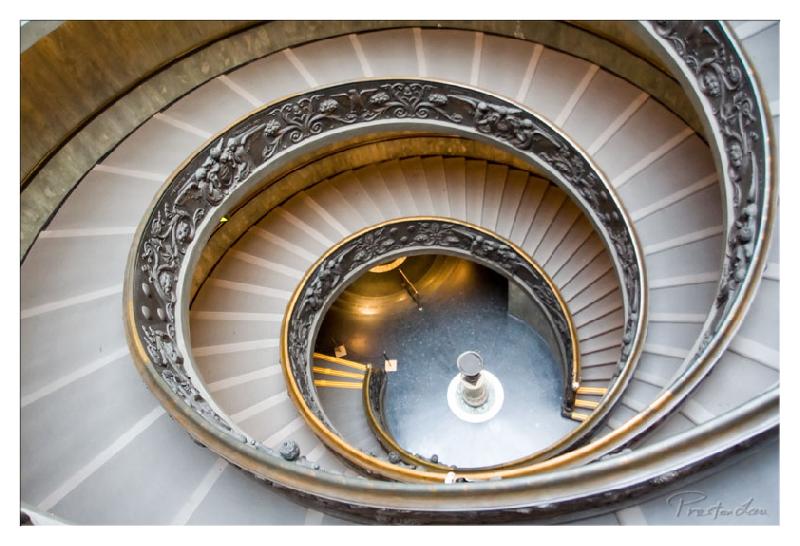

1. Overall Rating (0–10) — 8.0
This photograph captures the mesmerizing elegance of a spiraling staircase, evoking a sense of architectural grandeur and timeless movement. The tight overhead perspective draws the viewer’s eye into the center, creating a dynamic visual journey. While the ornate ironwork and symmetrical design are striking, the image’s emotional depth is slightly restrained by the absence of human presence, which keeps it more observational than immersive.
2. Composition (0–10) — 9.0
The circular symmetry and leading lines of the staircase create a powerful sense of motion and balance. The centered viewpoint enhances the hypnotic spiral, while the framing emphasizes the depth and scale of the structure.
3. Lighting (0–10) — 7.0
Soft, diffused lighting illuminates the spiral evenly, minimizing harsh shadows and highlighting the intricate details of the iron balustrade. The subtle glow at the center adds a focal point, though the lighting lacks dramatic contrast that might elevate the mood.
4. Color & Tone (0–10) — 7.5
The muted palette of gray stone and dark metal is complemented by warm golden highlights along the railings, creating a balanced and sophisticated tone. The limited color range enhances the timeless, classical feel of the architecture.
5. Creativity (0–10) — 8.0
The choice of a top-down perspective transforms a functional staircase into a compelling visual pattern, demonstrating a strong conceptual approach. The interplay between geometry and ornamentation reflects a thoughtful artistic vision.
6. Technical Quality (0–10) — 8.5
The image is sharp and well-focused, with excellent clarity in the fine details of the ironwork and stone treads. The depth of field is appropriately managed, keeping the entire spiral in focus.
7. Emotional Impact (0–10) — 7.5
The photograph conveys a quiet sense of awe and contemplation, inviting the viewer to imagine the countless footsteps that have traced this path. The architectural beauty and symmetry evoke a feeling of order and timelessness, though the lack of human context keeps the emotional connection somewhat detached.
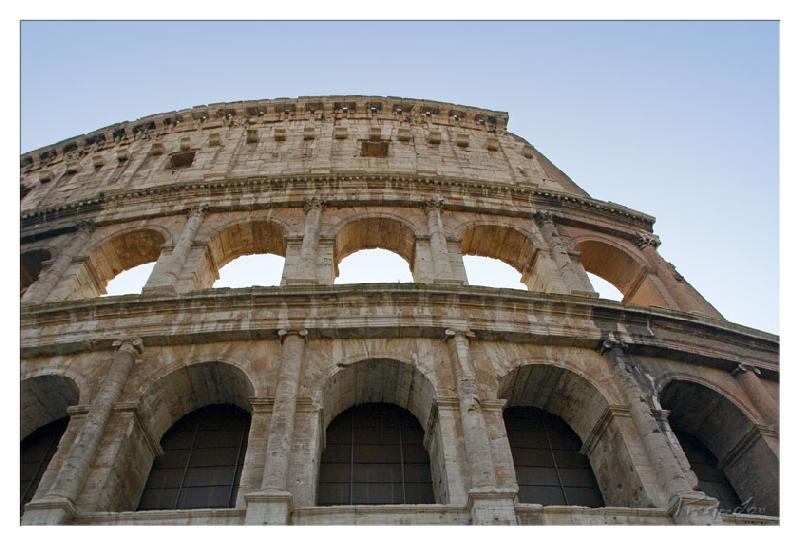

1. Overall Rating (0–10) — 7.5
This photograph captures the Colosseum with a sense of grandeur and timelessness, emphasizing its architectural majesty through a bold low-angle perspective. The warm stone contrasts beautifully with the clear blue sky, creating a striking visual balance that highlights the monument’s enduring presence. While the image is technically strong, its composition borders on conventional, limiting its emotional resonance to a more observational than evocative experience.
2. Composition (0–10) — 8.0
The low-angle view enhances the monument’s scale, with the arches leading the eye upward in a rhythmic pattern. The framing is tight yet balanced, emphasizing the curvature and symmetry of the structure while leaving enough sky to avoid overcrowding.
3. Lighting (0–10) — 8.0
Natural daylight bathes the Colosseum in soft, even light, highlighting the texture and weathering of the stone without harsh shadows. The clear sky provides a clean backdrop, enhancing the monument’s silhouette and emphasizing its verticality.
4. Color & Tone (0–10) — 7.5
The warm, earthy tones of the ancient stone contrast elegantly with the pale blue of the sky, creating a harmonious and timeless palette. The slight warmth enhances the historical feel, while the tonal range remains balanced and natural.
5. Creativity (0–10) — 7.0
The low-angle perspective is effective and familiar, offering a classic view of the Colosseum. While the image is well-executed, it leans toward the conventional rather than offering a unique or conceptual interpretation.
6. Technical Quality (0–10) — 8.5
Sharp focus across the structure, precise exposure, and clean detail in the stonework demonstrate strong technical control. The image is free from noise or distortion, with excellent clarity in both highlights and shadows.
7. Emotional Impact (0–10) — 7.0
The photograph evokes a sense of awe and reverence, capturing the Colosseum as a symbol of human achievement and endurance. While it is visually compelling, the emotional pull is more intellectual than visceral, inviting admiration rather than deep personal connection.
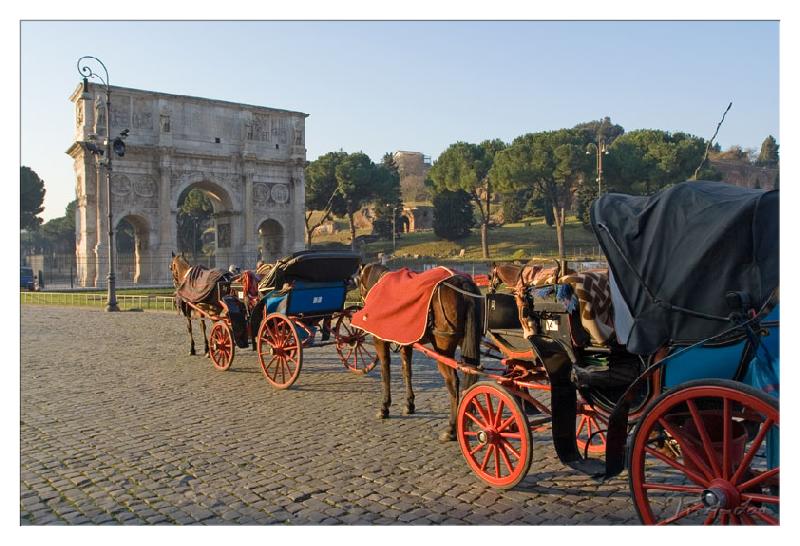

1. Overall Rating (0–10) — 7.0
This photograph captures a timeless scene in Rome, where ancient grandeur meets modern tourism with quiet elegance. The presence of horse-drawn carriages in the foreground adds a human scale and narrative warmth, while the Arch of Constantine stands as a stoic monument to history. The image is balanced and evocative, though the slight overexposure in the sky tempers its atmospheric depth.
2. Composition (0–10) — 7.5
The diagonal line of carriages leads the eye toward the arch, creating a strong sense of depth. The placement of the arch off-center adds visual interest, while the cobblestone foreground grounds the scene in texture and perspective.
3. Lighting (0–10) — 7.0
Soft morning light enhances the textures of the stone and horse blankets, casting gentle shadows that add dimension. The sky, though slightly washed out, supports a golden-hour feel that complements the historical mood.
4. Color & Tone (0–10) — 7.0
The warm tones of the red wheels and draped fabric create a striking contrast against the cool stone and blue sky. The color palette feels authentic and harmonious, though the sky’s pale blue lacks depth.
5. Creativity (0–10) — 6.5
The image presents a classic postcard view with strong storytelling potential, but it leans more toward documentation than bold artistic interpretation. The juxtaposition of ancient and contemporary elements is effective, yet not entirely surprising.
6. Technical Quality (0–10) — 8.0
Sharp focus across the frame, clean detail in the horse harness and cobblestones, and accurate exposure—aside from the overexposed sky—show strong technical control.
7. Emotional Impact (0–10) — 6.5
The photograph evokes a sense of nostalgia and quiet wonder, inviting the viewer to imagine the passage of time. While it resonates emotionally, it remains somewhat restrained in its ability to stir deeper reflection.

1. Overall Rating (0–10) — 7.5
This photograph captures the timeless grandeur of the Colosseum with a striking sense of historical weight and architectural rhythm. The warm golden light bathes the ancient brickwork, emphasizing texture and form, while the low-angle perspective draws the viewer into the structure’s imposing scale. Though the image is visually compelling, it slightly underplays the site’s full majesty by focusing on a single, unbroken section, leaving the broader context of the amphitheater less felt.
2. Composition (0–10) — 7.0
The low-angle view enhances the monumentality of the arches, leading the eye upward along the curve of the structure. The diagonal alignment of the brickwork creates dynamic movement, though the tight framing limits the sense of space and scale.
3. Lighting (0–10) — 8.5
The warm, directional light of late afternoon or early morning casts long shadows and highlights the texture of the brick, giving the structure a rich, golden glow. The contrast between the illuminated facade and the deep blue sky adds depth and drama.
4. Color & Tone (0–10) — 8.0
The warm, earthy tones of the brick harmonize beautifully with the clear blue sky, creating a balanced and visually pleasing palette. The subtle tonal gradations enhance the sense of age and weathering.
5. Creativity (0–10) — 7.5
The choice of angle and timing gives the image a strong narrative quality, evoking the passage of time and the endurance of human achievement. While the subject is familiar, the treatment feels both respectful and artistically intentional.
6. Technical Quality (0–10) — 8.0
The image is sharp and detailed, with excellent clarity in the brickwork and clean focus throughout. The exposure is well-managed, preserving detail in both highlights and shadows.
7. Emotional Impact (0–10) — 8.0
The photograph stirs a sense of awe and reverence, inviting contemplation of history, resilience, and the beauty of ancient engineering. The warm light and strong perspective create a deeply immersive experience.


1. Overall Rating (0–10) — 7.0
This photograph captures the solemn grandeur of a decaying ancient structure, where history is etched not only in stone but in the scars of time and conflict. The long perspective draws the viewer into a space burdened with silence and memory, while the subtle presence of visitors grounds the scene in the present. The image’s power lies in its restrained storytelling—its quiet tension between ruin and resilience—but it could benefit from a more dynamic interplay of light and shadow to heighten its emotional weight.
2. Composition (0–10) — 7.5
The receding arches create a strong linear perspective, guiding the eye deep into the corridor and emphasizing the scale and depth of the space. The placement of the figures near the center-right adds a sense of human scale without disrupting the symmetry, and the rough texture of the weathered walls provides visual interest along the frame.
3. Lighting (0–10) — 6.0
The lighting is functional but flat, with a strong contrast between the sunlit areas and the deep shadows. While the natural light highlights the texture of the stone, the lack of directional warmth or softness limits the atmospheric depth. The overexposed patches on the right wall detract slightly from the overall tonal harmony.
4. Color & Tone (0–10) — 6.5
The palette is muted and earthy, dominated by beige and gray tones that reinforce the aged, somber mood. The tonal range is adequate, but the lack of color saturation dulls the image’s vibrancy, making it feel more documentary than evocative.
5. Creativity (0–10) — 7.0
The photograph succeeds in capturing a powerful narrative of endurance and decay. The juxtaposition of ancient architecture with visible bullet holes suggests a layered history of conflict and survival. The composition is deliberate and meaningful, though it leans toward the familiar rather than the surprising.
6. Technical Quality (0–10) — 7.5
The image is sharp and well-focused, with clear detail in the stonework and architectural elements. The exposure is generally balanced, though some areas are slightly overexposed, and the resolution is sufficient to appreciate the textures.
7. Emotional Impact (0–10) — 7.5
There’s a palpable sense of melancholy and reverence in the image—the weight of history is almost tangible. The quiet emptiness, punctuated by the distant figures, invites reflection on loss, continuity, and the passage of time, making it emotionally resonant despite its restrained presentation.
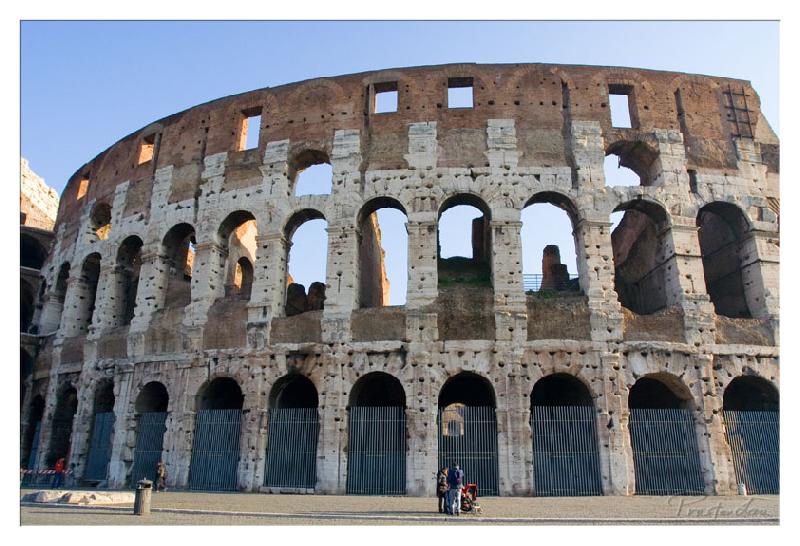

1. Overall Rating (0–10) — 7.0
This photograph captures the enduring grandeur of the Colosseum under a clear blue sky, evoking a sense of historical weight and architectural mastery. The warm sunlight enhances the texture of the ancient stone, while the presence of visitors grounds the monument in the present. Though the composition is effective, the wide angle slightly dilutes the monument’s vertical dominance, and the foreground figures, while adding scale, distract from the structure’s rhythmic arches.
2. Composition (0–10) — 6.5
The low-angle perspective emphasizes the Colosseum’s scale, but the wide framing includes too much of the ground and sky, reducing the visual impact. The arches create a strong horizontal rhythm, though the central placement of the structure feels slightly unbalanced by the asymmetrical gate closures.
3. Lighting (0–10) — 7.5
The bright, direct sunlight enhances the texture and depth of the stonework, casting subtle shadows that accentuate the layered arches. The clear blue sky provides a clean backdrop that makes the structure stand out, though the harshness of the light slightly flattens some of the finer details.
4. Color & Tone (0–10) — 7.0
The warm, golden tones of the aged stone contrast beautifully with the cool blue of the sky, creating a balanced and visually pleasing palette. The color saturation is natural and enhances the historic feel, though the overall tone leans slightly warm, which softens the contrast.
5. Creativity (0–10) — 6.5
The image offers a conventional yet effective view of a well-known landmark. While it successfully captures the monument’s scale and texture, it lacks a unique angle or narrative twist, relying more on familiarity than originality.
6. Technical Quality (0–10) — 8.0
The image is sharp and well-focused, with fine detail visible in the stonework. The exposure is balanced, and the digital clarity allows for appreciation of the architectural complexity.
7. Emotional Impact (0–10) — 7.0
The photograph evokes awe and reverence for the ancient world, with the human figures offering a sense of scale and continuity. It connects the viewer to history through visual grandeur, though the lack of a specific moment or story keeps the emotional resonance from fully resonating.
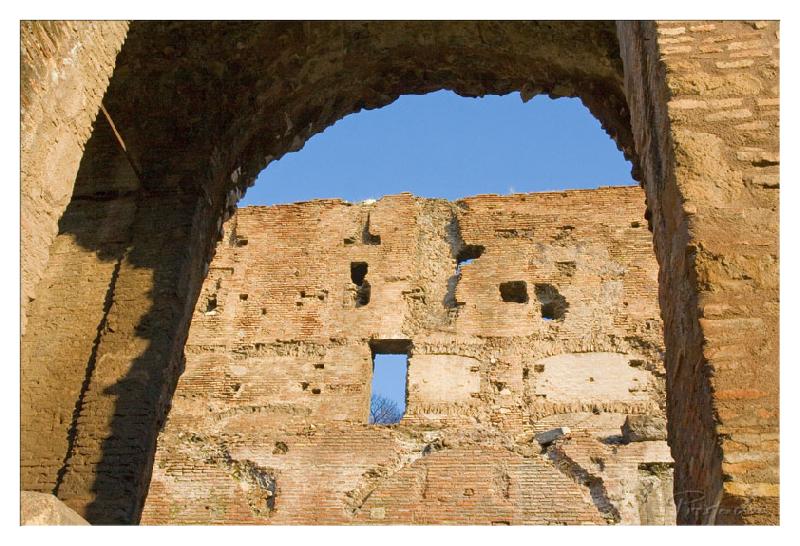

1. Overall Rating (0–10) — 7.5
This photograph captures the solemn grandeur of ancient ruins, where the passage of time is etched into every weathered brick. The archway acts as a natural frame, drawing the eye toward the sky and the remnants of a once-mighty structure, evoking a sense of historical reverence and quiet decay. While the image is visually compelling, the slightly overexposed sky and muted textures prevent it from achieving a more immersive depth.
2. Composition (0–10) — 8.0
The arch creates a strong, centered framing device, guiding the viewer’s gaze toward the textured wall and the rectangular window. The symmetry and layering of stone and sky lend balance and depth, though the composition could benefit from a more dynamic angle.
3. Lighting (0–10) — 7.0
The warm, golden light enhances the texture of the brick and casts deep shadows that emphasize the ruins’ age. However, the sky is slightly overexposed, losing detail in the brightest area and creating a harsh contrast with the darker masonry.
4. Color & Tone (0–10) — 7.5
The earthy tones of the red brick harmonize beautifully with the deep blue sky, creating a natural and evocative palette. The contrast between warm stone and cool sky adds visual interest, though the tones could be more saturated to heighten the image’s dramatic effect.
5. Creativity (0–10) — 8.0
The use of the arch as a framing device is both intentional and effective, transforming a simple ruin into a narrative portal. The juxtaposition of decay and sky suggests themes of endurance and time, giving the image a contemplative and poetic quality.
6. Technical Quality (0–10) — 7.5
The image is sharp and detailed, with clear texture in the stonework and good depth of field. Minor issues with sky exposure and slight noise in the darker areas reduce overall technical polish.
7. Emotional Impact (0–10) — 8.0
There’s a profound sense of timelessness and melancholy in the image, inviting reflection on impermanence and human achievement. The quiet dignity of the ruins resonates emotionally, connecting the viewer to a distant past.
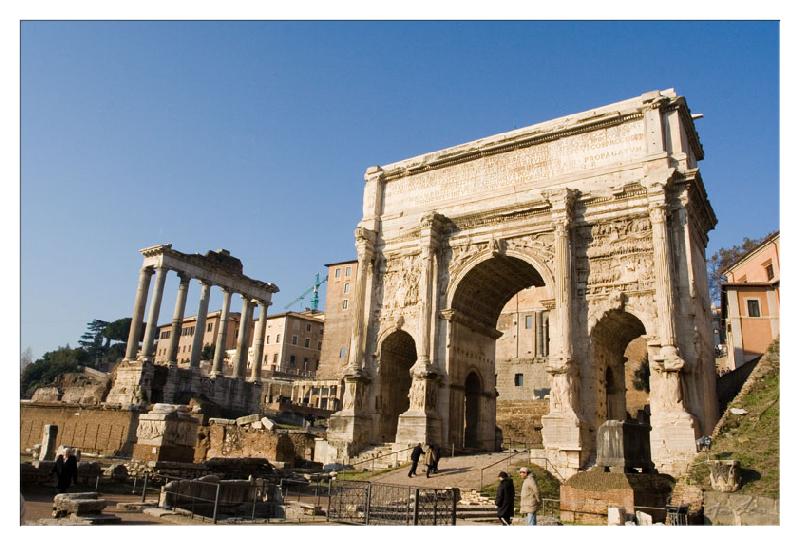

1. Overall Rating (0–10) — 7.0
This photograph captures the enduring grandeur of the Arch of Constantine against a vivid blue sky, evoking a sense of historical continuity and timelessness. The inclusion of visitors adds scale and life to the scene, grounding the monumental structure in present-day experience. While the image successfully conveys the site’s majesty, a slightly more dynamic angle or tighter framing could enhance its visual impact.
2. Composition (0–10) — 6.5
The arch dominates the right side of the frame, creating a strong focal point, while the Temple of Venus and Rome on the left provides visual balance. The low-angle perspective emphasizes the monument’s scale, though the wide shot includes distracting foreground elements that slightly dilute the composition’s focus.
3. Lighting (0–10) — 8.0
The bright, direct sunlight enhances the texture and detail of the stone, casting crisp shadows that add depth and dimension. The clear blue sky provides a clean, contrasting backdrop that makes the monument stand out with striking clarity.
4. Color & Tone (0–10) — 7.5
The warm, sunlit stone contrasts beautifully with the deep blue sky, creating a vibrant and harmonious palette. The natural tones of the ruins are well-preserved, with subtle variations in hue that reflect the weathering and age of the structure.
5. Creativity (0–10) — 6.5
The image presents a classic, documentary-style view of a historic landmark, capturing the site with respect and clarity. While it lacks bold artistic interpretation, its strength lies in its straightforward, reverent portrayal of a powerful historical artifact.
6. Technical Quality (0–10) — 8.0
The photograph is sharp and well-exposed, with fine detail visible in the stonework. The focus is consistent across the frame, and the image shows no signs of motion blur or technical flaws.
7. Emotional Impact (0–10) — 7.0
The scene inspires awe and reflection, evoking a connection to the past and the enduring legacy of ancient Rome. The presence of people walking through the ruins adds a human element that enhances the sense of scale and time, inviting viewers to imagine the site’s history.
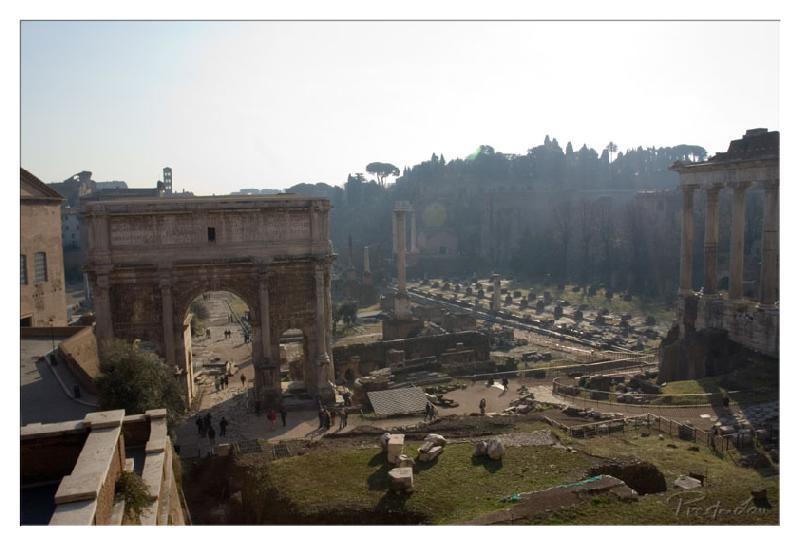

1. Overall Rating (0–10) — 7.0
This photograph captures the solemn grandeur of Rome’s ancient ruins, where time and decay intertwine in a quiet, meditative landscape. The soft haze and warm light lend a nostalgic quality, enhancing the sense of historical depth. While the composition is rich in context, the slightly overexposed sky and muted tonal range slightly dampen the image’s visual power, holding it back from true mastery.
2. Composition (0–10) — 6.5
The wide-angle view effectively conveys the scale of the site, with the Arch of Titus anchoring the left and the columns of the Temple of Saturn on the right creating a balanced frame. However, the foreground railing and uneven ground disrupt visual flow, and the distant figures appear lost in the open space.
3. Lighting (0–10) — 6.0
The soft, diffused sunlight creates gentle shadows and a hazy atmosphere, enhancing the timeless mood. Yet the bright sky is overexposed, losing detail in the upper portion and giving the image a flat, washed-out feel.
4. Color & Tone (0–10) — 6.5
The palette is dominated by earthy tones—ochre, beige, and muted greens—evoking the aged stone of antiquity. However, the colors lack vibrancy, and the overall tone is somewhat flat, reducing the richness of the scene.
5. Creativity (0–10) — 7.0
The image successfully captures the romantic melancholy of ancient ruins, with a contemplative mood that invites reflection. The framing suggests a personal, observational approach, lending the photograph a thoughtful, narrative quality.
6. Technical Quality (0–10) — 7.0
The image is sharp and detailed in the central ruins, with a clear focus on the arch and surrounding structures. The slight overexposure in the sky is the primary technical flaw, but the rest of the frame remains well-captured.
7. Emotional Impact (0–10) — 7.5
There is a quiet dignity in the ruins, and the hazy light imbues the scene with a sense of reverence and loss. The viewer is drawn into the weight of history, evoking a contemplative, almost melancholic connection to the past.
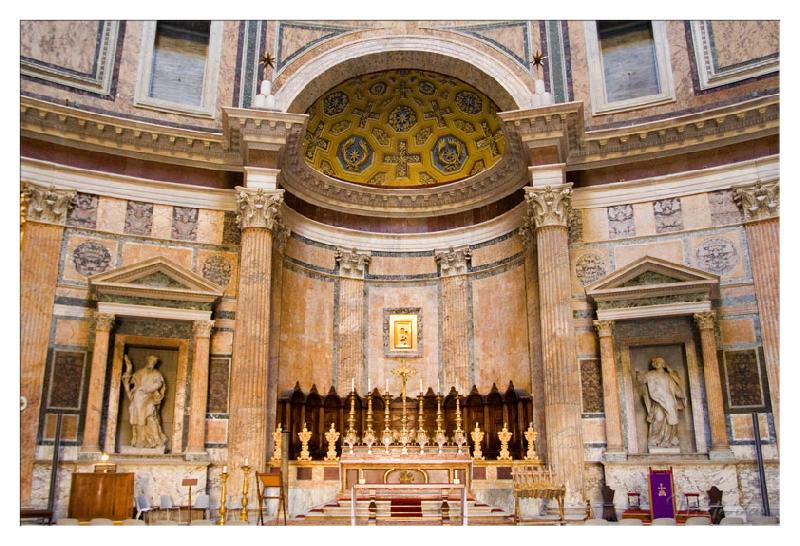

1. Overall Rating (0–10) — 8.0
This photograph captures the solemn grandeur of a historic church interior, where architectural splendor and sacred tradition converge. The rich textures of marble, the golden dome, and the symmetrical arrangement evoke a sense of reverence and timelessness. While the image is visually compelling, a subtle imbalance in lighting and composition slightly diminishes its overall harmony.
2. Composition (0–10) — 7.5
The central axis of the altar and dome creates a strong sense of symmetry, drawing the eye upward. However, the inclusion of modern furniture and objects on the periphery disrupts the classical elegance, creating a slight visual clutter.
3. Lighting (0–10) — 7.0
Natural light filters in from the upper windows, illuminating the dome and highlighting the gold accents. The lighting is generally even, though some areas of the lower walls remain in shadow, reducing detail in the foreground.
4. Color & Tone (0–10) — 8.0
The warm palette of gold, terracotta, and cream tones enhances the sense of antiquity and spiritual warmth. The golden dome stands out as a focal point, while the muted marble provides a refined contrast.
5. Creativity (0–10) — 7.5
The image successfully captures the interplay between architecture and devotion, presenting a space that is both sacred and historically rich. The framing emphasizes verticality and reverence, though it remains largely documentary in approach.
6. Technical Quality (0–10) — 8.5
Sharp focus and clear detail throughout the image demonstrate strong technical execution. The depth of field is well-managed, preserving clarity in both the foreground and the distant dome.
7. Emotional Impact (0–10) — 8.0
The photograph evokes a quiet awe, inviting contemplation of the space’s history and spiritual significance. The balance of light and form creates a meditative atmosphere that resonates with viewers familiar with religious architecture.
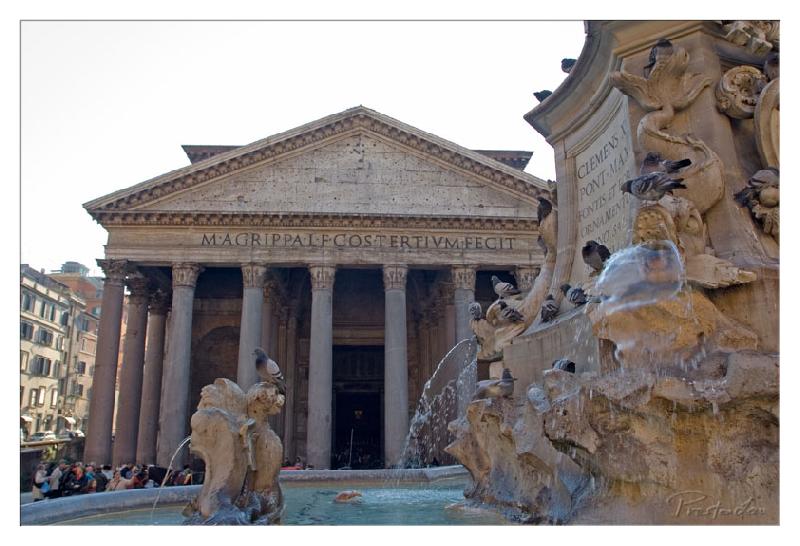

1. Overall Rating (0–10) — 7.0
This photograph captures the timeless grandeur of the Pantheon and the bustling energy of the Piazza della Rotonda, where ancient history meets modern life. The interplay between the classical architecture and the dynamic fountain in the foreground creates a compelling narrative of continuity and time. While the image is rich in historical context, the slightly overexposed sky and cluttered foreground slightly dilute its visual impact, holding back its potential to feel truly cinematic.
2. Composition (0–10) — 7.0
The Pantheon is well-centered, anchoring the frame, while the fountain on the right adds depth and visual interest. The diagonal flow of the water and the placement of the pigeons create a natural leading line toward the temple, though the foreground activity risks distraction.
3. Lighting (0–10) — 6.0
The soft, diffused light of an overcast day evenly illuminates the scene, preserving detail in the stone carvings and reducing harsh shadows. However, the sky is slightly washed out, diminishing atmospheric contrast and lending a flatness to the upper portion of the frame.
4. Color & Tone (0–10) — 6.5
The warm, earthy tones of the travertine stone harmonize beautifully with the cool blues of the water, creating a balanced palette. The overall tone is natural but restrained, with a slight lack of vibrancy that keeps the image from feeling vivid or immersive.
5. Creativity (0–10) — 7.0
The juxtaposition of the ancient temple with the lively fountain and urban life offers a fresh perspective on a well-documented landmark. The inclusion of the pigeons and people adds narrative layers, transforming the image from a simple architectural shot into a living scene.
6. Technical Quality (0–10) — 7.5
The focus is sharp on the Pantheon’s facade and the fountain’s sculptures, with good clarity throughout. The watermark is subtle and does not detract from the image. The exposure is mostly accurate, though the highlights in the sky could be better controlled.
7. Emotional Impact (0–10) — 6.5
The image evokes a sense of awe and continuity, inviting viewers to reflect on the endurance of human achievement. The presence of people and birds adds life and warmth, but the emotional resonance is held back by the somewhat distant and observational framing.


1. Overall Rating (0–10) — 7.0
This photograph captures the vibrant energy of a bustling European piazza, where the whimsy of a balloon artist contrasts with the historical gravitas of the fountain behind him. The scene is rich with narrative—tourists, vendors, and performers coexist in a moment of urban life—yet the composition’s busyness risks diluting the focus. While the image celebrates spontaneity and color, a more deliberate framing could elevate its visual cohesion.
2. Composition (0–10) — 6.5
The subject is well-placed in the right foreground, drawing the eye, but the crowded background and uneven depth create visual clutter. A tighter crop would emphasize the balloon artist’s craft and reduce distractions.
3. Lighting (0–10) — 7.5
Bright, natural sunlight enhances the vividness of the balloon colors and casts crisp shadows, giving the scene a lively, midday clarity. The light direction adds depth and highlights textures in both the sculpture and the artist’s clothing.
4. Color & Tone (0–10) — 8.0
The palette is rich and varied—bold primary colors of the balloons pop against the earthy tones of the buildings and pavement. The warm sunlight enhances saturation without overpowering, creating a cheerful, dynamic atmosphere.
5. Creativity (0–10) — 7.0
The juxtaposition of the playful balloon artist against the classical sculpture offers a compelling cultural contrast. The image tells a story of tradition meeting modern street life, though the execution remains largely observational rather than interpretive.
6. Technical Quality (0–10) — 8.0
Sharp focus on the balloon artist and the foreground elements, with clean detail in the textures of the balloon sculptures and fabric. The exposure is well-balanced, capturing both highlights and shadows effectively.
7. Emotional Impact (0–10) — 7.5
The image evokes a sense of joy and spontaneity, drawing the viewer into a moment of celebration and human connection. The artist’s expressive face and the playful balloons convey warmth, while the historic setting adds a layer of timeless charm.
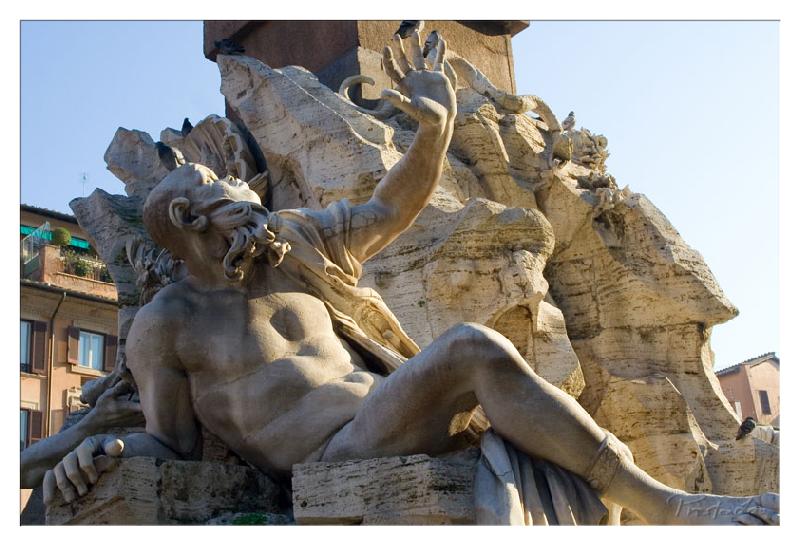

1. Overall Rating (0–10) — 7.0
This photograph captures the dramatic intensity of a Baroque sculptural fountain, where mythic struggle is rendered in stone with powerful physicality. The dynamic pose of the central figure, combined with the textured, weathered stone and the interplay of light and shadow, gives the image a sense of ancient grandeur and emotional weight. While the framing feels slightly unbalanced and the background distractions weaken the focus, the image succeeds in conveying the monument’s theatricality and historical gravitas.
2. Composition (0–10) — 6.0
The low-angle perspective emphasizes the sculpture’s scale and drama, but the inclusion of the building and sky on the left creates an uneven visual weight, pulling attention away from the central figure.
3. Lighting (0–10) — 7.0
Strong, directional sunlight from the upper left accentuates the sculptural form, carving out the musculature and folds of drapery with dramatic contrast. The highlights and shadows enhance the three-dimensionality and emotional tension of the scene.
4. Color & Tone (0–10) — 6.0
The palette is dominated by warm, earthy stone tones, with a slightly muted sky that prevents the scene from feeling overly vibrant. The lack of rich color is fitting for the subject, but a bit more tonal depth could enhance the image’s atmospheric quality.
5. Creativity (0–10) — 7.0
The choice to frame the sculpture from a low angle and emphasize its dynamic pose reflects a strong interpretive vision. The image captures not just a monument, but a moment of mythic struggle, lending it a narrative depth beyond mere documentation.
6. Technical Quality (0–10) — 7.5
Sharp focus and clear detail highlight the intricate textures of the marble, and the exposure is well-balanced despite the bright daylight. The image is technically sound and conveys the materiality of the sculpture effectively.
7. Emotional Impact (0–10) — 7.5
The tension in the figure’s expression and posture—strained, defiant, and almost pleading—resonates with a sense of epic struggle, evoking awe and a touch of melancholy. The viewer is drawn into the sculptural drama, creating a powerful, if somber, emotional connection.
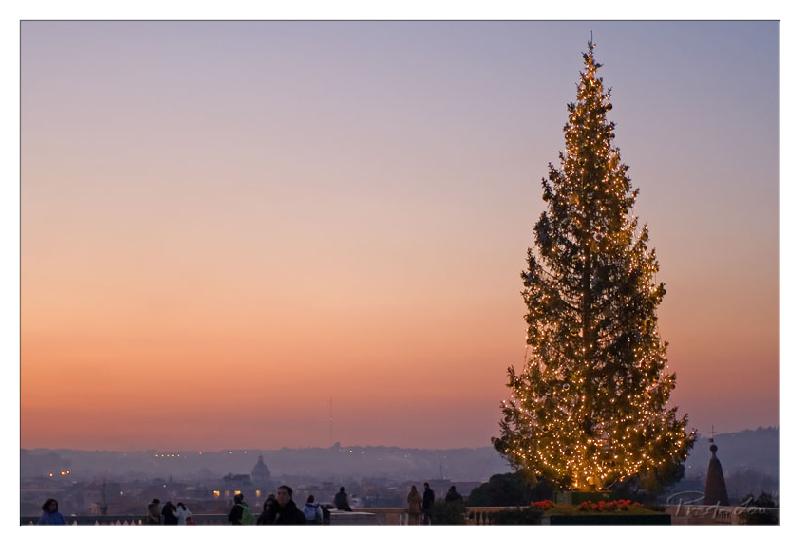

1. Overall Rating (0–10) — 7.5
This photograph captures a serene and celebratory moment as a towering Christmas tree glows against the soft gradient of a twilight sky. The warm lights of the tree contrast beautifully with the cool hues of the evening, creating a tranquil yet festive atmosphere. While the composition is strong and emotionally resonant, a more deliberate framing could elevate the sense of scale and intimacy with the scene.
2. Composition (0–10) — 7.0
The tree is placed off-center, drawing the eye while allowing the expansive sky and distant cityscape to balance the frame. The silhouetted figures in the foreground add a sense of scale and human presence, grounding the image in a shared cultural moment.
3. Lighting (0–10) — 8.0
The interplay of natural twilight and the artificial glow of the tree lights creates a warm, inviting ambiance. The soft, diffused light of dusk enhances the golden tones of the tree, while the subtle backlighting on the silhouettes adds depth and dimension.
4. Color & Tone (0–10) — 8.0
The palette transitions smoothly from deep orange near the horizon to soft lavender above, complementing the golden-yellow lights of the tree. The tonal harmony enhances the calm mood, with just enough contrast to keep the scene visually engaging.
5. Creativity (0–10) — 7.5
The image captures a familiar holiday scene with a sense of quiet grandeur, blending the personal (the tree, the people) with the monumental (the cityscape). The choice to shoot during the golden hour adds a poetic quality, transforming a public celebration into a contemplative moment.
6. Technical Quality (0–10) — 8.0
The image is sharp and well-exposed, with clean detail in both the illuminated tree and the distant city. The focus is consistent, and the dynamic range is well-handled, preserving details in both the highlights and shadows.
7. Emotional Impact (0–10) — 8.5
The photograph evokes a strong sense of nostalgia and communal warmth, capturing the quiet magic of the holiday season. The combination of light, color, and scale invites the viewer into a moment of shared celebration, making it both personal and universal.


1. Overall Rating (0–10) — 7.5
This photograph captures the serene transition from dusk to night over Rome, blending warm ambient light with the quiet glow of city lights. The composition draws the eye toward St. Peter’s Basilica, anchoring the scene in historical and spiritual significance. While the image conveys a strong sense of place and atmosphere, the slightly overexposed street lights and muted sky tones temper its visual impact, preventing it from achieving full luminous depth.
2. Composition (0–10) — 8.0
The obelisk in the foreground provides a strong vertical anchor, leading the eye down the long axis of the piazza toward the distant dome. The diagonal flow of lights along the street enhances depth and perspective, while the balanced framing gives the scene a sense of order and harmony.
3. Lighting (0–10) — 7.0
The golden hour glow casts a warm, soft light across the cityscape, creating a tranquil mood. However, the artificial lights from the street lamps and buildings appear slightly harsh and overexposed, competing with the natural light and reducing the subtlety of the evening sky.
4. Color & Tone (0–10) — 7.5
The palette features a rich blend of warm oranges and yellows in the sky, complemented by the deep shadows and golden tones of the illuminated buildings. The color contrast between the warm sky and the cooler city lights adds visual interest, though the overall saturation is slightly uneven.
5. Creativity (0–10) — 7.0
The image successfully captures a classic Roman vista with a contemplative mood, offering a timeless perspective of the city. The choice to include the long exposure effect enhances the sense of movement and life, though the composition follows a conventional approach.
6. Technical Quality (0–10) — 8.0
The image is sharp and well-focused, with clear details in the architecture and foreground elements. The long exposure is executed cleanly, with no visible motion blur or noise, indicating strong technical control.
7. Emotional Impact (0–10) — 8.0
There is a palpable sense of peace and timelessness, evoking a quiet reverence for the city’s history and beauty. The viewer is drawn into a moment of stillness, as if witnessing a sacred threshold between day and night.
Loading map...